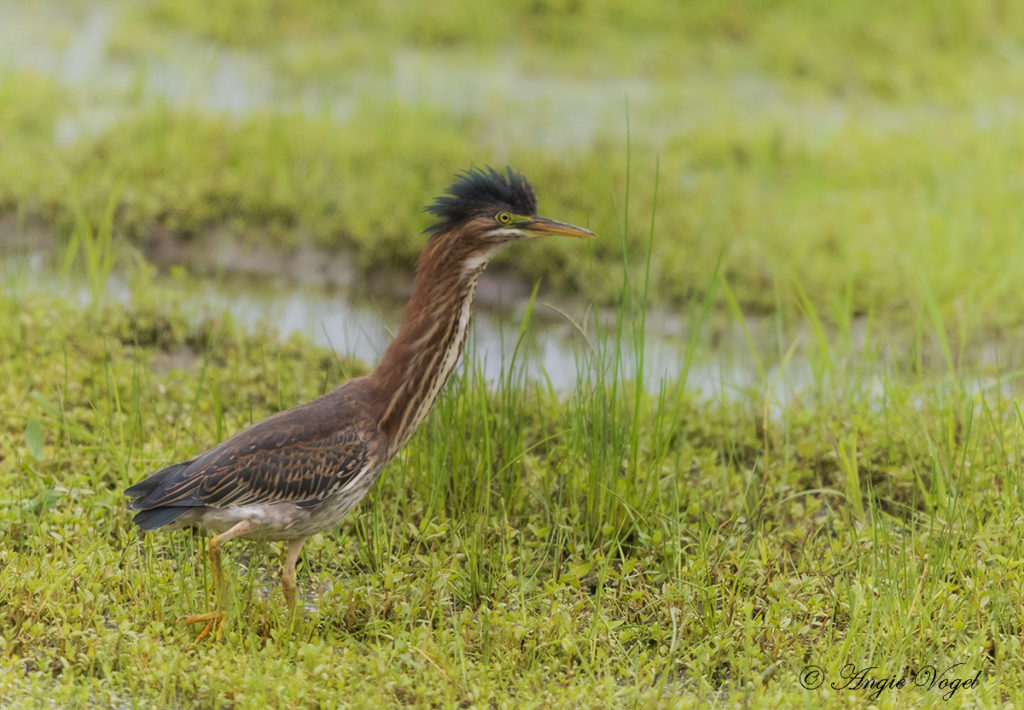Green Heron
Butorides virescens
 Unlike most herons, the Green Heron is a short and stocky bird with short legs and broad, rounded wings. If you’re lucky enough to get a close-up peek, it’s a very handsome bird with an iridescent green back, deep chestnut upper body, and an intimidating long, dagger-like bill.
Unlike most herons, the Green Heron is a short and stocky bird with short legs and broad, rounded wings. If you’re lucky enough to get a close-up peek, it’s a very handsome bird with an iridescent green back, deep chestnut upper body, and an intimidating long, dagger-like bill.
This small heron is mostly solitary and often secretive. They live around marshy or swampy areas, wooded ponds, and other wet habitats with cover to provide a more secluded nest site. They’re common breeders in coastal and inland wetlands, and have been spotted on the Refuge recently, as they’re known to potentially breed in this region in summer months. They’ll nest in various places, including willow thickets, mangroves, dry woods, and open marsh.
The Green Heron dines mainly on small fish, but will also eat insects, spiders, crustaceans, snails, amphibians, even reptiles and rodents! They hunt by crouching patiently at the water’s edge to spear small fish with its heavy, menacing bill. Interestingly, it may even try to use bait to catch fish, like a real fisherman, using a feather or small twig, even insects. It’s also known to hunt in deeper water by plunging down on its prey from above. They hunt at all times of day or night.
When it’s time to nest, the male will pick a secluded area within his territory, usually in a large fork of a tree or bush with overhanging branches to camouflage the nest from view. The nest is usually on or over the water, and can be anywhere from ground level to up to 30 feet off the ground, sometimes even higher.
The male begins to build the nest before pairing with a female to breed, but after he has his girl all lined up, he’ll pass off the rest of the job to her. As the male gathers thin sticks, the female will then shape them into a nest between 8–12 inches in diameter, with a shallow bottom and no lining. They may renovate an old nest, or build in an area with old nests around. They may nest as an isolated duo, or in small groups. They will vigorously defend their nest areas from predators, including other Green Herons, crows and similar birds, and even snakes and raccoons.
Each breeding season, the Green Heron will pair up with one mate, performing bold courtship displays such as stretching it’s neck, exaggerated wing flaps, snapping its bill and loud calling. Both the male and female brood and feed the chicks, which may stay with their parents for more than a month after leaving their nest, learning to forage.
There are usually 1 or 2 broods per year, each yielding between 3-5 eggs, but sometimes as many as 7. Both male and female incubate the eggs (for about 20 days), and both also feed their young, by regurgitation. The young herons will begin to climb around the near nest after about 2 weeks or so, then will make their first flight at about 3 weeks of age.
Green Herons are still common, but their population is in a state of gradual decline. This decline has been recorded across most of the bird’s range, except California, which showed an increase in population. Green Herons can be found throughout the year across the U.S. Today, the biggest threat to Green Herons is gradual loss of habitat through draining or development of wetlands, although it’s hard to know for sure, since they are solitary and widely dispersed.
Cool Facts
Photo Credit: Angie Vogel